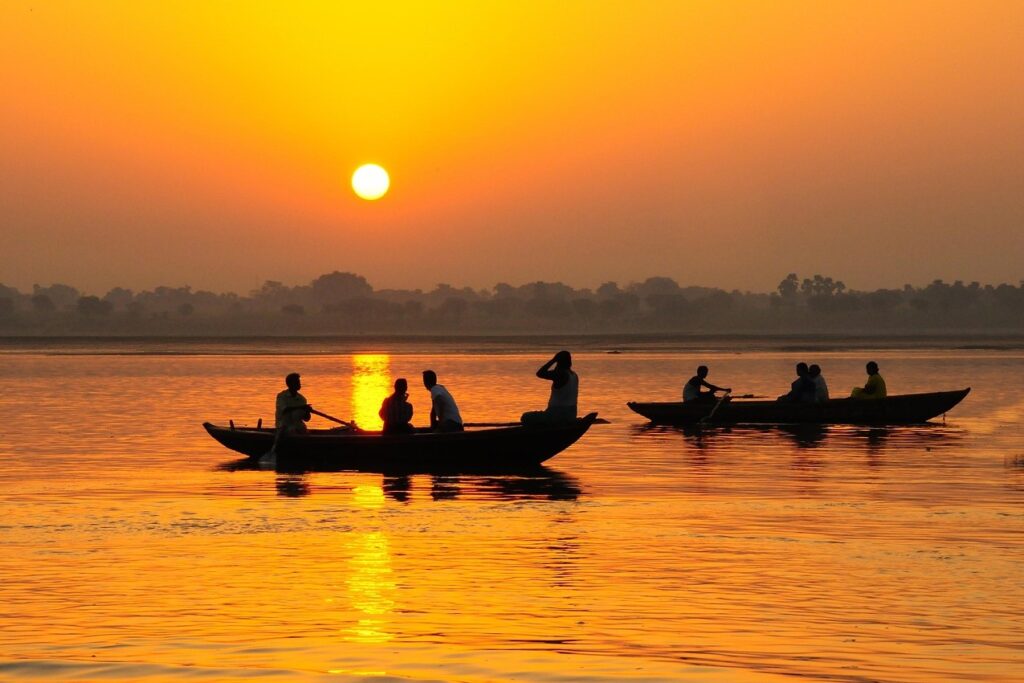The Ganga River is a major river in the Indian subcontinent. It is a lifeline to millions of people living along its course and is considered sacred by the Hindus. The total length of the Ganga is 2,525 kilometers and it feeds a large delta before emptying into the Bay of Bengal.
The course of the Ganga River
In India
It is after the confluence of rivers Alaknanda and Bhagirathi, the river formed is known as Ganga. The source of the Alaknanda River is the Satopanth glacier and the source of the Bhagirathi River is the Gangotri glacier. The Ganga River runs through the states of Uttarakhand, Uttar Pradesh, Bihar, Jharkhand, and West Bengal where many big rivers join Ganga as its tributaries e.g.,
- Yamuna joins Ganga at Prayagraj, Uttar Pradesh
- Ghaghara joins Ganga at Revelganj, Bihar
- Gandak joins Ganga near Patna, Bihar
Before entering Bangladesh Ganga bifurcates into two rivers, Hooghly and Padma. The Hooghly flows through West Bengal into the Bay of Bengal while the Padma flows eastwards towards Bangladesh.
In Bangladesh
The Ganga is known as ‘Padma’ in Bangladesh. The Jamuna River, the largest distributary of Brahmaputra joins the Padma first. After flowing for some kilometers as the Padma, the Meghna River joins and the river thereafter is known as Meghna which empties into the Bay of Bengal.

What makes Ganga River (Ganges) so special?
The antibacterial property of Ganga water
The Ganga water contains more than 1,100 kinds of antibacterial agents, as found in a study commissioned by the Union Water Resource Ministry. These agents are more likely to be found in the Himalayan stretches of the river. The number of antibacterial agents in the Ganga is more than the number of antibacterial agents in any other river in India. Despite all this, Ganga water is not suitable for drinking and bathing because of the river pollution.
Ganges river dolphin
There are very few rivers in the world in which dolphins are found and Ganga is one of them. The Ganges river dolphin is a threatened species found in Ganga and Brahmaputra and their tributaries. The dolphin population is estimated at around 3,500. These dolphins have already become extinct in many stretches of the rivers. River pollution, construction of dams, and illegal trade are major reasons responsible.
Ganges delta
The Ganges delta/Ganges-Brahmaputra delta/Sundarbans delta is the world’s largest delta. Approximately 60% of the delta is in Bangladesh and the rest is in India. The ecosystem of this delta is one of a kind. The delta supports more than 300 million human population and is home to some enthralling flora and fauna including the Royal Bengal tiger.
Sacredness
The Ganga has a lot of religious and cultural importance in India. The river is worshipped by the Hindus as ‘Mother Ganga’. Hindus believe that taking a dip in Ganga may wash away their sins. There are many pilgrimages associated with Ganga, one of those, the Kumbh Mela is the largest human gathering in the world.
Sustaining property
No other river in the world sustains as much life as Ganga does. You cannot imagine an Indian subcontinent blooming with life without Ganga.
The future of the Ganga as a perennial river is uncertain as both the Gangotri and Santopanth glaciers are receding because of global warming. If Ganga becomes a seasonal river after a few hundred years then it will not be as special as it is today. The Ganga water may not be antibacterial, the Ganges delta may not be the largest, the dolphins may not exist, and the Ganga may lose its sacredness.
Disclaimer: The stats may change with time.
Read more